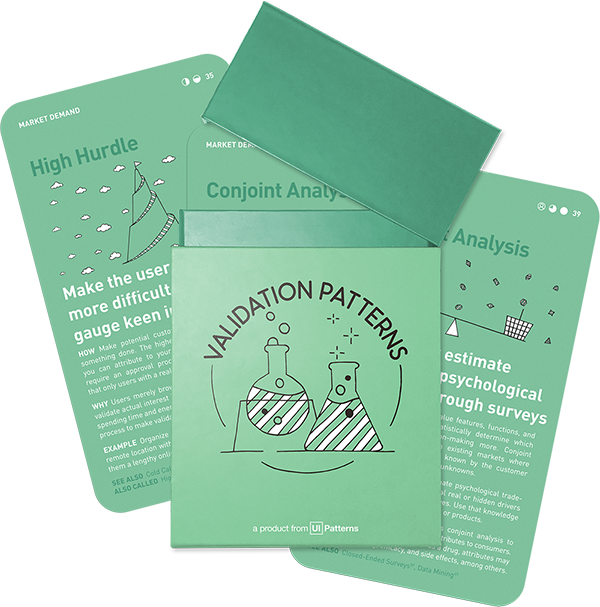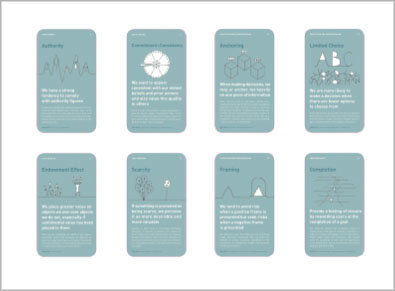Idea Validation: Product
Minimum Marketable Product
A product with just enough functionality to be viable to launch

How: A Minimum Marketable Product (MMP) is a functional version of your product, but with features stripped down to the bare minimum in order to collect the maximum amount of validated learning about customers with the least amount of effort.
Why: Reduce time-to-market by building the absolute minimum product you can get away with launching. This approach is often less expensive than going to market with a final and full product experience, which might fail. An MMP is often informed by one or more Minimum Viable Products (MVPs). While appropriate for finally launching, you should have validated your product before launching.
Testing the coherent whole
A Minimum Marketable Product (MMP) is not so much a testing method as it defines the first responsible moment to market your product to a larger audience. In that way, an MMP bundles many underlying and hopefully tested assumptions together into a coherent whole, which can then be tested.
The concept of a Minimum Marketable Product (MMP), closely related to the Minimum Viable Product (MVP). It revolves around the idea of creating a product with the minimum set of features that are enough to satisfy early customers and provide feedback for future product development.
An MMP focuses on developing a product that has just enough features to be viable and marketable. This approach is designed to reduce the time and resources spent on developing features that might not appeal to the market. The primary objective is to launch a product quickly, gather feedback from real users, and iterate based on that feedback.
Getting market validation
MMP is an effective tool for market validation, although probably the most expensive and time consuming experiment of them all. Having said that, developing an MMP is generally more cost-effective than a full-featured product. It requires less time and resources, reducing the initial investment and risk. This efficiency is particularly beneficial for startups and small businesses with limited budgets.
By releasing a product with core functionalities, companies can test their hypotheses about market needs and demands. This feedback-driven approach allows for more informed decisions about product development and helps in identifying the product-market fit.
Setting up a feedback loop and a foundation for iterative development
An MMP creates a feedback loop with its users. Early adopters use the product and provide valuable insights on its usability, features, and potential improvements. This user feedback is crucial for refining the product and aligning it more closely with customer needs.
The MMP approach supports iterative development. Based on user feedback, companies can make incremental changes and enhancements to the product. This continuous improvement process helps in adapting to changing market trends and customer preferences.
MMP fits well with lean and agile methodologies, which emphasize flexibility, efficiency, and customer feedback. This integration allows for a more dynamic and responsive approach to product development, crucial in today’s competitive business environment.
Real life Minimum Marketable Product examples
Uber
Initially launched as UberCabs, it was a basic iPhone app for connecting users with cab drivers, allowing payments via credit card. The app started with simple graphics and a manual process, where the CEO contacted drivers directly. Uber’s initial success in its MVP stage allowed it to expand and add more sophisticated features over time.
Source: 11 Best Examples of Successful Minimum Viable Product. MVPs case studies from real business.
It began as Burbn, an app that wasn’t primarily focused on photo sharing. The app initially offered various functionalities but was complex and confusing. The founders noticed that photo sharing was popular among users and pivoted to focus solely on this feature, eventually evolving into Instagram.
Source: 11 Best Examples of Successful Minimum Viable Product. MVPs case studies from real business.
Canva
Beginning as a simple graphic design tool with templates for non-designers, Canva focused on simplicity and ease of use, which contributed to its rapid growth and success.
Source: 12 Real-Life Examples of Successful Minimum Viable Products
Airbnb
Started as a simple one-page website created by the founders when they needed to earn extra money by renting out space in their apartment. The immediate demand they saw from their first guests validated their business idea, leading to the significant growth of Airbnb.
Source: 11 Best Examples of Successful Minimum Viable Product. MVPs case studies from real business
Mint
Launched as a simple investment tracker, Mint quickly grew into a leading financial application for managing personal finances, differentiating itself by compiling data from various financial institutions.
Source: 12 Real-Life Examples of Successful Minimum Viable Products
HubSpot
Started as a blog focusing on content marketing and lead generation, HubSpot’s success and user feedback led to the development of a comprehensive CRM platform.
Source: 12 Real-Life Examples of Successful Minimum Viable Products
Grammarly
Initially aimed at helping students improve their writing, Grammarly quickly gained popularity and expanded its functionalities beyond basic spell checking.
Source: 12 Real-Life Examples of Successful Minimum Viable Products
A collection of 60 product experiments that will validate your idea in a matter of days, not months. They are regularly used by product builders at companies like Google, Facebook, Dropbox, and Amazon.
Get your deck!Related plays
- The Minimum Viable Product & the Minimal Marketable Product by Geert Skovbo

